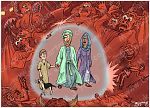Bible Cartoon: <-- 2 Thessalonians : 1 Timothy -->
Click on Add to cart button below shopping cart.
Purchased Bible Cartoons do not have watermarks. Links to Cartoons provided on email once purchase is completed.1 Timothy
Book type: Letter (Epistle)
Author: Apostle Paul
No. of chapters: 6
Key character(s): God, Jesus, Paul, Timothy [1]
Brief description: 1 Timothy – Instructions for church leaders.
01) Greeting: The instructions for church leaders come from one who has authority from the Lord (1:1-12)
02) Spiritual church leaders are stewards of the gospel of Jesus the Christ (1:3-20)
03) Spiritual church leaders must lead the church in worship of God (2:1-15)
04) Spiritual church leaders must meet the highest qualifications (3:1-16)
05) Spiritual church leaders must have integrity in their ministry activity (4:1-16)
06) Spiritual church leaders must show true concern for their congregations welfare (5:1-6:2)
07) Spiritual church leaders must take care in relating to material things (6:3-21)
Paul‘s first letter to Timothy, the young leader of the Ephesian church, who was experiencing some problematic issues with his congregation. Paul’s letter to Timothy (written from Macedonia) addresses the relational, ministerial & financial issues the young pastor faced. Paul recommended (if not commanded!) proper understanding of the Law (Torah) whilst warning against wandering away from the truth of the Gospel of Jesus the Christ, into false asceticism, meaningless talk & the doctrine of deamons, which perhaps manifested itself as early Gnostic thought in the church of Ephesus.
It is interesting to note how contemporary these issues seem to the modern church, some 2000 years after the letter was first written! The world has changed much sine the first century AD, but church congregations face the same issues & need the same advice, regardless of the passage of time. That is because churches are made up of human beings & regardless of the age, we always need reminders of how to behave in the House of God.
Theological conclusions.
Paul wrote a very practical letter to his young friend & co-worker Timothy, emphasising:
01) The supreme value of the Gospel of Jesus the Christ.
02) The demonic character of the corruption of the Gospel.
03) The high calling of the church.
04) The qualifications essential in a spiritual church leader.
The emphasis Paul puts into his instructions is about what kind of person a church leader should be, rather than how they are to do their work.
Whilst Paul’s letter does not present a complete statement of church faith, it does provide helpful insights into the nature & character of faith:
01) The goal of teaching in church is instilling a pure heart of love in the believer (1:5).
02) The church is to faithfully teach “the glorious gospel of the blessed God” (1:11).
03) The church’s teaching does not give attention to unhelpful fables, meaningless talk, endless genealogies or the doctrines of demons (1:4,6; 4:1-7).
04) Church leaders are to teach lessons based on great doctrinal truths (1:15; 2:4-7; 3:16; 4:10).
05) The church’s teachings give proper place & emphasis on the nature of God’s church itself (3:15).
06) Godly living is always encouraged (6:3).
07) The words of Jesus are held in the highest esteem & adhered to (6:3).
Contemporary teaching.
Paul’s advice & instructions to Timothy are especially relevant to today’s churches. We often view the size of a given congregation as a measure of its apparent success. Paul cautioned all church leaders (pastors, vicars, preachers, etc) to behave with humility, highest moral, indifference to riches & with a permanent focus on the master shepherd: Jesus the Christ.
Paul set out the moral & practical requirements for overseers and deacons (3:1-13).
Paul expressed that churches must teach the true gospel of salvation, which comes through faith in Jesus Christ, apart from human effort. This is so important that Paul repeats the message in closing part of the last chapter (6:11-16) as a charge to Timothy.
Key Verses:
1 Timothy 2:5-6 (ANIV)
For there is one God and one mediator between God and men, the man Christ Jesus, who gave himself as a ransom for all men—the testimony given in its proper time.
1 Timothy 4:12 (ANIV)
Don’t let anyone look down on you because you are young, but set an example for the believers in speech, in life, in love, in faith and in purity.
1 Timothy 6:10-11 (ANIV)
For the love of money is a root of all kinds of evil. Some people, eager for money, have wandered from the faith and pierced themselves with many griefs. But you, man of God, flee from all this, and pursue righteousness, godliness, faith, love, endurance and gentleness.
[1]
Fuller list of major characters in 1 Timothy:
| Name | Notes |
| Jesus | ”Saviour”. Christ means “the Anointed One”. (aka Jesus of Nazareth, The Christ, The Messiah, Son of man, Son of God). The central figure of the New Testament, whose life, death, and resurrection are chronicled in the 4 Gospel books. |
| Paul | (aka Saul, “Asked for” Hebrew.) Native of Tarsus, the capital of Cilicia, a Roman province in the south-east of Asia Minor. Jew with Roman citizenship; Pharisee; persecutor of the early Christian church. Converted from Judaism to Christianity after encounter with resurrected Jesus on the road to Damascus (Acts 9:1-30). Thereafter called an apostle (Ro 1:1, 1Co 1:1, 2Co 1:1, Gal 1:1, Eph 1:, Col 1:1, 1Ti 1:1, 2Ti 1:1, Tit 1:1). Author of at least 13 of the 27 books of the New Testament: Romans, Phillipians, 1 & 2 Timothy, 1 & 2 Corinthians, Colossians, Titus, 1 & 2 Thessalonians, Philemon, Galatians, Ephesians. |
| Timothy | Τιμόθεος, Timótheos. Mother was a Jewess convert to Christianity, his father was Greek (Acts 16:1). Resident, and probable native of Lystra a city of Lycaonia. Apostle Paul’s companion and fellow-laborer, one of Paul’s own converts (1 Corinthians 4:17). (Acts 17:14; Acts 18:5; Acts 19:22; Acts 20:4; Romans 16:21; 1 Cor. 4:17; 1 Cor. 16:10; 2 Cor. 1:1, 19; Phil. 1:1; Phil. 2:19; Col. 1:1; 1 Thes. 1:1; 1 Thes. 3:2, 6; 2 Thes. 1:1; 1 Tim. 1:2, 18; 1 Tim. 6:20; 2 Tim. 1:2; Philemon 1:1; Hebrews 13:23) |





